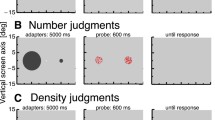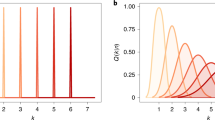Abstract
Numerosity illusions emerge when the stimuli in one set are overestimated or underestimated relative to the number (or quantity) of stimuli in another set. In the case of multi-item arrays, individual items that form a better Gestalt are more readily grouped, leading to overestimation by human adults and children. As an example, the Solitaire illusion emerges when dots forming a central cluster (cross-pattern) are overestimated relative to the same number of dots on the periphery of the array. Although this illusion is robustly experienced by human adults, previous studies have produced weaker illusory results for young children, chimpanzees, rhesus macaques, capuchin monkeys, and guppies. In the current study, we presented nonhuman primates with other linear arrangements of stimuli from Frith and Frith’s (Percept Psychoph 11:409–410, 1972) original paper with human participants that included the Solitaire illusion. Capuchin monkeys, rhesus macaques, and human adults learned to quantify black and white dots that were presented within intermingled arrays, responding on the basis of the more numerous dot colors. Humans perceived the various illusions similar to the original findings of Frith and Frith (1972), validating the current comparative design; however, there was no evidence of illusory susceptibility in either species of monkey. These results are considered in light of illusion susceptibility among primates as well as considering the role of numerical discrimination abilities and perceptual processing mode on illusion emergence.




Similar content being viewed by others
Change history
19 July 2019
In the original publication, values of last three rows in Table 1 and Table 2 were incorrectly published.
References
Agrillo C, Miletto Petrazzini ME, Dadda M (2013) Illusory patterns are fishy for fish, too. Front Neural Circuits 7:137
Agrillo C, Parrish AE, Beran MJ (2014a) Do rhesus monkeys (Macaca mulatta) perceive the Zöllner illusion? Psychon Bull Rev 21:986–994
Agrillo C, Parrish AE, Beran MJ (2014b) Do primates see the Solitaire illusion differently? A comparative assessment of humans (Homo sapiens), chimpanzees (Pan troglodytes), rhesus monkeys (Macaca mulatta) and capuchin monkeys (Cebus apella). J Comp Psychol 128:402–413
Agrillo C, Miletto Petrazzini ME, Bisazza A (2016a) Brightness illusion in the guppy (Poecilia reticulata). J Comp Psychol 130:55–61
Agrillo C, Parrish AE, Beran MJ (2016b) How illusory is the Solitaire illusion? Assessing the degree of misperception of numerosity in adult humans. Front Psychol 7:1663. https://doi.org/10.3389/fpsyg.2016.01663
Allik J, Tuulmets T (1991) Occupancy model of perceived numerosity. Percept Psychophys 49:303–314
Barbet I, Fagot J (2002) Perception of the corridor illusion by baboons (Papio papio). Behav Brain Res 132:111–115
Beran MJ (2006) Quantity perception by adult humans (Homo sapiens), chimpanzees (Pan troglodytes), and rhesus macaques (Macaca mulatta) as a function of stimulus organization. Int J Comp Psychol 19:386–397
Beran MJ, Parrish AE, Evans TA (2015) Numerical cognition and quantitative abilities in nonhuman primates. In: Geary DC, Berch DB, Koepke KM (eds) Evolutionary origins and early development of number processing, vol 1. Academic Press, San Diego, pp 91–119
Bertamini M, Guest M, Vallortigara G, Rugani R, Regolin L (2018) The effect of clustering on perceived quantity in humans (Homo sapiens) and in chicks (Gallus gallus). J Comp Psychol 132:280–293
Billino J, Hamburger K, Gegenfurtner KR (2009) Age effects on the perception of motion illusions. Perception 38:508–521
Brannon EM (2006) The representation of numerical magnitude. Curr Opin Neurobiol 16:222–229
Bravo M, Blake R, Morrison S (1988) Cats see subjective contours. Vision Res 28:861–865
De Lillo C, Spinozzi G, Truppa V, Naylor DM (2005) A comparative analysis of global and local processing of hierarchical visual stimuli in young children (Homo sapiens) and monkeys (Cebus apella). J Comp Psychol 119:155–165
Doherty MJ, Campbell NM, Tsuji H, Phillips WA (2010) The Ebbinghaus illusion deceives adults but not young children. Dev Sci 13:714–721
Dominguez KE (1954) A study of visual illusions in the monkey. J Genetic Psychol 85:105–127
Evans TA, Beran MJ, Chan B, Klein ED, Menzel CR (2008) An efficient computerized testing method for the capuchin monkey (Cebus apella): adaptation of the LRC-CTS to a socially housed nonhuman primate species. Behav Res Methods 40:590–596
Fraser A, Wilcox KJ (1979) Perception of illusory movement. Nature 281:565–566
Frith CD, Frith U (1972) The solitaire illusion: an illusion of numerosity. Percept Psychophys 11:409–410
Fujita K (1996) Linear perspective and the Ponzo illusion: a comparison between rhesus monkeys and humans. Jap Psychol Res 38:136–145
Fujita K (1997) Perception of the Ponzo illusion by rhesus monkeys, chimpanzees, and humans: similarity and difference in the three primate species. Percept Psychophys 59:284–292
Fujita K, Blough DS, Blough PM (1991) Pigeons see the Ponzo illusion. Anim Learn Behav 19:283–293
Fuss T, Schluessel V (2017) The Ebbinghaus illusion in the gray bamboo shark (Chiloscyllium griseum) in comparison to the teleost damselfish (Chromis chromis). Zoology 123:16–29
Ginsburg N (1976) Effect of item arrangement on perceived numerosity: randomness vs regularity. Percept Motor Skill 43:663–668
Ginsburg N (1980) The regular-random numerosity illusion: rectangular patterns. J Gen Psychol 103:211–216
Gori S, Agrillo C, Dadda M, Bisazza A (2014) Do fish perceive illusory motion? Sci Rep UK 4:6443
Hopkins WD, Washburn DA (2002) Matching visual stimuli on the basis of global and local features by chimpanzees (Pan troglodytes) and rhesus monkeys (Macaca mulatta). Anim Cogn 5:27–31
Howard SR, Avargues-Weber A, Garcia JE, Stuart-Fox D, Dyer AG (2017) Perception of contextual size illusions by honeybees in restricted and unrestricted viewing conditions. Proc Roy Soc B Biol Sci 284:20172278
Kanizsa G, Renzi P, Conte S, Compostella C, Guerani L (1993) Amodal completion in mouse vision. Perception 22:713–721
Miletto Petrazzini ME, Parrish AE, Beran MJ, Agrillo C (2018) Exploring the Solitaire illusion in guppies (Poecilia reticulata). J Comp Psychol 132:48–57
Murayama T, Usui A, Takeda E, Kato K, Maejima K (2012) Relative size discrimination and perception of the Ebbinghaus illusion in a bottlenose dolphin (Tursiops truncatus). Aquat Mamm 38:333–342
Nakamura N, Watanabe S, Fujita K (2008) Pigeons perceive the Ebbinghaus–Titchener circles as an assimilation illusion. J Exp Psychol Anim Behav Process 34:375–387
Nieder A (2002) Seeing more than meets the eye: processing of illusory contours in animals. J Comp Physiol A 188:249–260
Parrish AE, Beran MJ (2014) When less is more: like humans, chimpanzees (Pan troglodytes) misperceive food amounts based on plate size. Anim Cogn 17:427–434
Parrish AE, Brosnan SF, Beran MJ (2015) Do you see what I see? A comparative investigation of the Delboeuf illusion in humans (Homo sapiens), rhesus monkeys (Macaca mulatta), and capuchin monkeys (Cebus apella). J Exp Psych Anim Learn Cogn 41:395–405
Parrish AE, Agrillo C, Perdue BM, Beran MJ (2016) The elusive illusion: do children (Homo sapiens) and capuchin monkeys (Cebus apella) see the solitaire illusion? J Exp Child Psychol 142:83–95
Parrish AE, James BT, Beran MJ (2017) Exploring whether nonhuman primates show a bias to overestimate dense quantities. J Comp Psychol 131:59–68
Pepperberg IM (2017) Review of studies on visual perception in grey parrots (Psittacus erithacus): the Müller–Lyer illusion, amodal and modal completion. Anim Beh Cogn 4:378–395
Richardson WK, Washburn DA, Hopkins WD, Savage-Rumbaugh ES, Rumbaugh DM (1990) The NASA/LRC computerized test system. Behav Res Meth Instr Comp 22:127–131
Rosa Salva O, Rugani R, Cavazzana A, Regolin L, Vallortigara G (2013) Perception of the Ebbinghaus illusion in four-day-old domestic chicks (Gallus gallus). Anim Cogn 16:895–906
Sovrano VA, Albertazzi L, Rosa Salva O (2015) The Ebbinghaus illusion in a fish (Xenotoca eiseni). Anim Cogn 18:533–542
Spinozzi G, De Lillo C, Truppa V (2003) Global and local processing of hierarchical visual stimuli in tufted capuchin monkeys (Cebus apella). J Comp Psychol 117:15–23
Spinozzi G, De Lillo C, Truppa V, Castorina G (2009) The relative use of proximity, shape similarity, and orientation as visual perceptual grouping cues in tufted capuchin monkeys (Cebus apella) and humans (Homo sapiens). J Comp Psychol 123:56–68
Suganuma E, Pessoa VF, Monge-Fuentes V, Castro BM, Tavares MCH (2007) Perception of the Müller–Lyer illusion in capuchin monkeys (Cebus apella). Behav Brain Res 182:67–72
Uller C, Urquhart C, Lewis J, Berntsen M (2013) Ten-month-old infants’ reaching choices for “more”: the relationship between inter-stimulus distance and number. Front Psychol 4:84. https://doi.org/10.3389/fpsyg.2013.00084
Wertheimer M (1923) Untersunchungen zur lehre der gestalt. Psychol Forsch 4:301–350
Acknowledgements
This research was supported by NICHD grant HD060563 to M.J.B and by a Stars@unipd (Acronym: ANIM_ILLUS) grant from University of Padova to C.A and supported by the research grant ‘Dipartimenti di Eccellenza’ entitled: ‘Innovative methods or technologies for assessment, intervention, or enhancement of psychological functions (cognitive, emotional or behavioural)’. All aspects of this research conformed to national and international standards for the ethical treatment of animals and the testing of captive nonhuman primates. The authors declare that they have no conflicts of interest.
Author information
Authors and Affiliations
Corresponding authors
Additional information
Publisher's Note
Springer Nature remains neutral with regard to jurisdictional claims in published maps and institutional affiliations.
Rights and permissions
About this article
Cite this article
Parrish, A.E., Beran, M.J. & Agrillo, C. Linear numerosity illusions in capuchin monkeys (Sapajus apella), rhesus macaques (Macaca mulatta), and humans (Homo sapiens). Anim Cogn 22, 883–895 (2019). https://doi.org/10.1007/s10071-019-01288-9
Received:
Revised:
Accepted:
Published:
Issue Date:
DOI: https://doi.org/10.1007/s10071-019-01288-9




